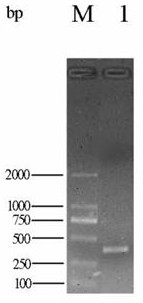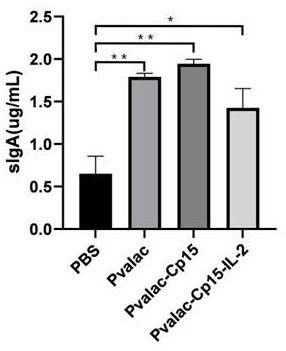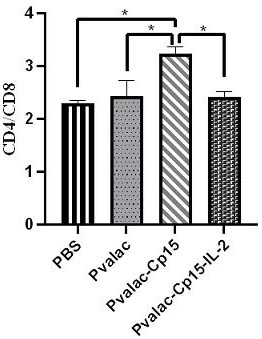Cryptosporidium parvum Cp15 recombinant invasive lactic acid bacteria live vector vaccine
A technology of Cryptosporidium parvum and live vector vaccines, which is applied in the fields of vaccines, recombinant DNA technology, and the use of vectors to introduce foreign genetic materials. Effects of reducing oocyst discharge, simple preparation method, and convenient use
- Summary
- Abstract
- Description
- Claims
- Application Information
AI Technical Summary
Problems solved by technology
Method used
Image
Examples
Embodiment 1
[0049] Amplification of Gene Cp15 of Cryptosporidium parvum
[0050] Using the cDNA of Cryptosporidium parvum as a template, the Cp15 gene was amplified, and the primers were designed as follows:
[0051] Upstream Cp15F:
[0052] GG ACTAGT TCTGCACTTCTGATCCTAGCTTGTTGGAGCTGCAGTTGCTATGAAATTG;
[0053] Downstream Cp15R:
[0054] CCG CTCGAG TTAATGGTGATGGTGATGATGCTTTAGAGGAATGAATCTGGAAGAA;
[0055] The single-line marks represent restriction sites Spe I and Xho I, respectively. The PCR reaction system is: template 1 μL, upstream primer 1 μL, downstream primer 1 μL, rTaq enzyme 0.5 μL, ddH 2 O 37.5 μL, dNTP 4 μL, 6×Buffer 5 μL. The PCR reaction conditions were as follows: pre-denaturation at 95°C for 5 min; denaturation at 95°C for 30 s, annealing at 57°C for 30 s, extension at 72°C for 30 s, and a total of 35 cycles, with a final extension at 72°C for 10 min. The PCR product was separated and identified by 1% agarose gel electrophoresis, and a band of about 432 bp was seen ...
Embodiment 2
[0057] Amplification of Cryptosporidium parvum Gene Cp15-IL-2
[0058] Using the cDNA of Cryptosporidium parvum as a template, the Cp15 gene fragment connected with the flexible fragment Linker was amplified. Upstream Cp15F:
[0059] CGG ACTAGT TCTGCACTTCTGATCCTAGCTTGTTGGAGCTGCAGTTGCTATGAAATTG;
[0060] Downstream Cp15Rlinker:
[0061] AGATCCGCCACCGCCAGAGCCACCTCCGCCTGAACCGCCTCCACC CTTTAGAGGAATGAATCTGG;
[0062] The underlined marks are the enzyme cutting site Spe I and the linker gene sequence of the flexible linker fragment respectively. The PCR reaction system is: template 1 μL, upstream primer 1 μL, downstream primer Cp15linker 1 μL, rTaq enzyme 0.5 μL, ddH 2 O 37.5 μL, dNTP 4 μL, 6×Buffer 5 μL. The PCR reaction conditions were as follows: pre-denaturation at 95°C for 5 min; denaturation at 95°C for 30 s, annealing at 68°C for 30 s, extension at 72°C for 30 s, and a total of 35 cycles, with a final extension at 72°C for 10 min. The PCR product was separated and id...
Embodiment 3
[0070] Construction of eukaryotic expression vectors of Cp15 and Cp15-IL-2
[0071] Digest the recovered and purified Cp15 and Cp15-IL-2 PCR products and pValac plasmid respectively. The enzyme digestion reaction system is: PCR product / pValac plasmid 16 μL, fast cutting enzyme Spe I and Xho I each 1 μL, 10×Buffer 2 μL . The enzyme digestion reaction conditions were: 37°C, 20 min. The digested products were identified and recovered by 1% agarose gel electrophoresis. Cp15 and Cp15-IL-2 PCR digested products were ligated with pValac vector with DNA ligase. Ligation reaction system: PCR digested product 4 μL, pValac plasmid 4 μL, DNA ligase 1 μL, 10×Buffer 1 μL. The reaction conditions are: 25°C, 2h. The ligation product was transformed into DH5α competent cells, and the positive colonies were screened and cultured with liquid LB. Use the plasmid mini-extraction kit to extract the plasmid according to the instructions and identify it by enzyme digestion. The enzyme digestion p...
PUM
 Login to View More
Login to View More Abstract
Description
Claims
Application Information
 Login to View More
Login to View More - R&D
- Intellectual Property
- Life Sciences
- Materials
- Tech Scout
- Unparalleled Data Quality
- Higher Quality Content
- 60% Fewer Hallucinations
Browse by: Latest US Patents, China's latest patents, Technical Efficacy Thesaurus, Application Domain, Technology Topic, Popular Technical Reports.
© 2025 PatSnap. All rights reserved.Legal|Privacy policy|Modern Slavery Act Transparency Statement|Sitemap|About US| Contact US: help@patsnap.com



